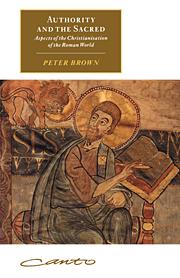THE LIMITS OF INTOLERANCE
Published online by Cambridge University Press: 18 April 2011
Summary
I have been prompted to re-think the problem of intolerance in the later empire by the experience of my nephew when, at the age of three, he paid his first visit to the Cincinnati Zoo. He already knew what all the animals looked like. He had seen pictures of elephants, giraffes, lions and walruses. But the only living animal that he had actually seen was his own pet cat, Teddy. Naturally, he assumed, therefore, that all animals were the same size as that cat – and, consequently, that they were smaller than himself: a flattering assumption. The fact that the animals in the zoo were all of very different sizes – some, indeed, immeasurably larger than himself – came as a great surprise to him. On seeing two Bengal tigers eating their lunch, he exclaimed: ‘Big, BIG cats!’, and remained silent, adtonitus, for a full twenty minutes, until a visit to the bird-house restored his overshadowed ego.
Religious intolerance is a phenomenon that bulks large in any history of late antiquity, to such an extent that it colours our perception of the entire quality of the age. The historian who wishes to form a just estimate of its nature, extent and effects has to face the same puzzlement as did this young fellow. We are dealing with a phenomenon that is documented in vivid, and seemingly unambiguous, fragments of evidence. The problem is, how to assess the relative size of the phenomena to which the fragments allude.
- Type
- Chapter
- Information
- Authority and the SacredAspects of the Christianisation of the Roman World, pp. 27 - 54Publisher: Cambridge University PressPrint publication year: 1997



